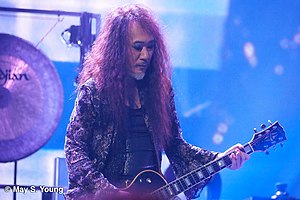Pata (musician)
| Pata | |
|---|---|

Pata at Madison Square Garden, New York, 2014.
|
|
| Background information | |
| Birth name | Tomoaki Ishizuka |
| Born |
November 4, 1965 Chiba, Japan |
| Genres | Rock, heavy metal, blues rock |
| Occupation(s) | Musician |
| Instruments | Guitar |
| Years active | 1980–present |
| Labels | |
| Associated acts | |
| Website | pata-official.com |
| Notable instruments | |
Tomoaki Ishizuka (石塚 智昭 Ishizuka Tomoaki?, born November 4, 1965 in Chiba), known exclusively by his stage name Pata, is a Japanese musician, best known as rhythm guitarist for the heavy metal band X Japan. He joined the band in 1987, stayed with them until their dissolution in 1997 and rejoined when the band started a comeback in 2007.
A year after their breakup, he formed the short-lived duo P.A.F. with singer NoB and created the band Dope HEADz with X Japan bassist Heath and former Spread Beaver percussionist/programmer I.N.A. in 2000. Right after they ceased activity, Pata formed the instrumental band Ra:IN in 2002, which still tours extensively to this day.
Little is known about Pata's early years as he tends to keep his past and personal life to himself. He taught himself to play guitar on a . He formed his first band in 1980, and two years later created the band Black Rose, later known as Judy, but chose to disband it in 1985 or 1986. Prior to disbanding, Yoshiki filled in on drums at several performances. Pata actually asked Yoshiki to join Judy, as at the time X Japan was going through member changes, but he declined. According to Yoko of United, Pata was a roadie for brief X member Hally and used Hally's guitar when he joined X himself.
Pata first played with X Japan (then named X) in 1987 as a session musician, on the songs "Stab Me in the Back" and "No Connexion" for the sampler Skull Thrash Zone Volume I. After supporting them at a couple live shows, he officially joined the band later that year. They released their first album Vanishing Vision in 1988 and toured extensively in support of the record. They would become one of the first Japanese acts to achieve mainstream success while on an independent label, and later widely credited as one of the pioneers of visual kei.
...
Wikipedia
